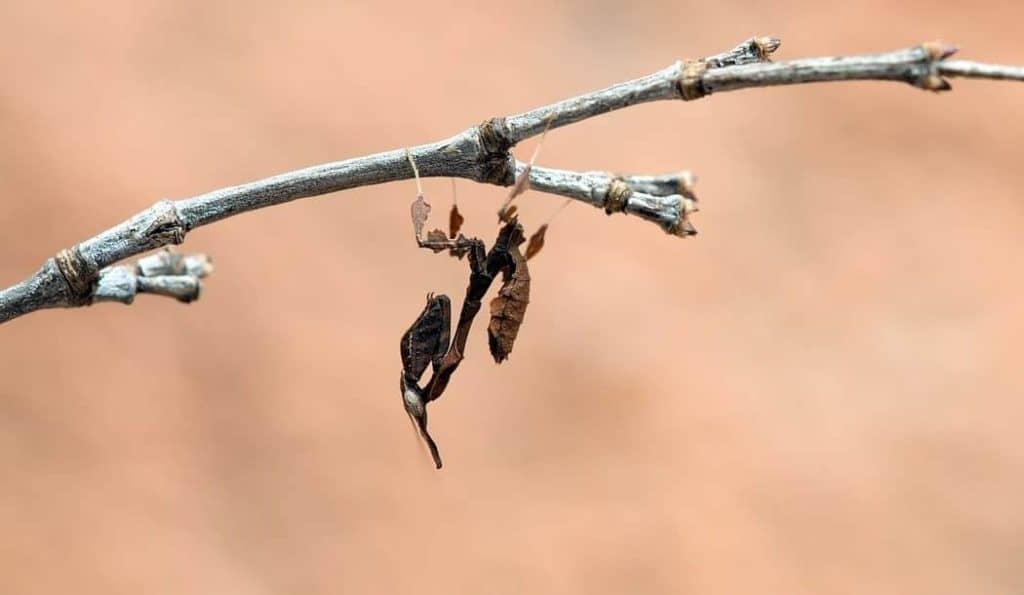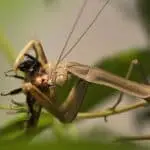I am sure you are worried when your mantis refuses to eat. Here are the 9 reasons why your mantis refuses to eat and what you should do.
Your mantis has specific food preferences.
Flies, crickets, and roaches are generally acceptable by mantises. Conversely, the mantises unlikely take ants and beetles. Certain mantis species can be picky in their diet.
For instance, flower mantises (eg. orchid flower mantis, devil flower mantis) prefer flies than other insects. Make sure you offer your mantis the right feeder insects.
Refer to this guide on the feeder insects that you can feed to your mantis.

The prey is too big.
While mantises are good hunters, many are hesitant to attack prey bigger than them. This is because mantises, especially nymphs, are not strong enough to deal with huge prey. Sometimes, omnivorous insects such as crickets can even attack the smaller or weaker mantis.
As a general rule of thumb, always offer your mantis with food smaller than, or not more than the size of the mantis. The younger the mantis, the more unlikely it attacks bigger prey, even if the prey is the same size as the mantis.
Your mantis is sick.
When mantis is sick, they may lose appetite and stop feeding. Symptoms include vomiting and passing out dark or brownish liquid.
When this happens, let your mantis drink more water or 10% honey instead. Simply wet 1 end of a chopstick (or anything similar) with water or 10% honey and point it toward the mouthparts of the mantis to feed it. Do this twice a day until your mantis regains appetite to feed.
So, what makes your mantis fall sick? Most likely it’s due to food poisoning. A mantis that has consumed pesticide-contaminated food can fall sick. Make sure you feed your mantis with insects from a clean and reliable source. Do not feed them with insects that you have caught from the wild because they might have contacted pesticides.
Unhygienic feeder insects can also cause food poisoning. Some hobbyists noted that feeders, especially crickets fed with low quality or dirty food or reared in an unhygienic environment, can cause their mantises to fall sick. Change the food source if required. If you are keeping your own feeder crickets, make sure you feed them with decent quality food.
Your mantis is molting soon, or your mantis has just molted.
A mantis will stop feeding and becomes inactive when it is going to molt. Most probably it will hang on to a twig, upside down. You shouldn’t worry too much about food at this stage. Instead, make sure the housing is adequately humid so the mantis can molt successfully.
When the mantis molts, it “changes” a new skin. The newly formed skin, or more accurately the exoskeleton, is soft. This makes the mantis vulnerable. Make sure no feeder insects are inside the mantis enclosure.
After hardening its exoskeleton, the mantis will become active again. Now you can feed them. Do note that sometimes it may take an extra few more days before it starts feeding.
It is too cold!
Not sure if you have noticed, when you turn on the air conditioner in the summer, you get lesser mosquitoes biting you. This is because many insects become inactive when it gets cooler, including mantises.
When the temperature is too low, the mantis moves less, and stops eating. You should always check the temperature requirement for the species that you are keeping, and use a heat mat to regulate the temperature if required.
The mantis is going to give birth soon.
If your mantis is a female, has mated and has a swollen stomach, it is likely that she is going to give birth soon. A gravid female mantis may stop feeding until she has laid her eggs. Hence, it is important to feed her well before letting her mates.
Do bear in mind that certain mantis species such as the Brunner’s mantis and Springbok mantis lay eggs without mating. In this case, swelling stomach is an indicator to look at if they stop feeding.
There are no twigs in the enclosure

Certain species, such as the flower mantises, prefer to hunt on twigs. They usually sit there and wait for their prey to come to them. When twigs are not available, they have problem hunting.
Having twigs in the enclosure also allows the mantis camouflage better, thereby increasing the rate of successful hunting. Always make sure you decorate the enclosure with some twigs so that the mantis can hunt comfortably.
Your mantis is dehydrated
When your mantis is dehydrated, they may lose interest to prey because their utmost priority is to get some water. Always mist your enclosure from time to time so that your mantis get enough moisture and water.
If your mantis is big in size, you can sprinkle some water into the enclosure. The mantis will drink the water droplet.
You can also spoon-feed your mantis with water. Just dip one end of a chopstick or anything similar into water and offer the water to your mantis.
Your mantis is too old.
Another possibility is that your mantis has become too old to eat. Depending on species, mantises live for a few months up to a year. Male mantises generally live shorter lives compared to female mantises, and females mantises live longer if they don’t lay eggs.
There isn’t anything much that you can do if that’s the case. Prepare your mantis a small funeral, get out of sorrow and get yourself a new mantis!
What should I Do if My Mantis Refuses to Eat?
Relax! When your mantis refuses to eat, go through the 9 points which I’ve mentioned earlier. You would more or less know which is the contributing factor and take the necessary action.
Now that you know what causes your mantis to stop feeding, I am sure you can take care of it better! You can get more information on how to keep your mantis from this guide. Don’t forget to check out my recommended books to learn more about keeping mantises too!


